If you’ve been around dinghy-sailing a while, there is a better-than-average chance that you’ve come across the venerable Sunfish (or have mistaken one of its many imitators for a Sunfish). Audrey has been messing about with Sunfish since 1982, and she first capsized one with me onboard in 1984. Through the years we’ve spent many memorable hours sailing this simple boat and have had immeasurable fun restoring old and well-used, even abused basket-case boats.
The Sunfish, a direct descendant of the 1945 Sailfish, was the creation of ALCORT Sailboats, founded by Alex Bryan and Cortlandt Heniger. A hollow-bodied wooden “sit-on” sailboat, the Sailfish was featured in LIFE magazine’s 1949 article “World’s Wettest, Sportiest Boat.” It went through various iterations and in 1952, the designers at ALCORT, with considerable input from Aileen Shields Bryan, introduced a new iteration they called the Sunfish. Aileen was considered one of the best female sailors of the day, having won the 1948 Adams Cup—the Women’s National Sailing Championship—as well as the Atlantic and 210 class championships. She recommended adding a small cockpit as a foot well for more comfort, and widening the hull by 12″ for more stability. Since 1952 the Sunfish has been in continuous production and by 2013, more than 500,000 had been built and sailed in over 50 countries.
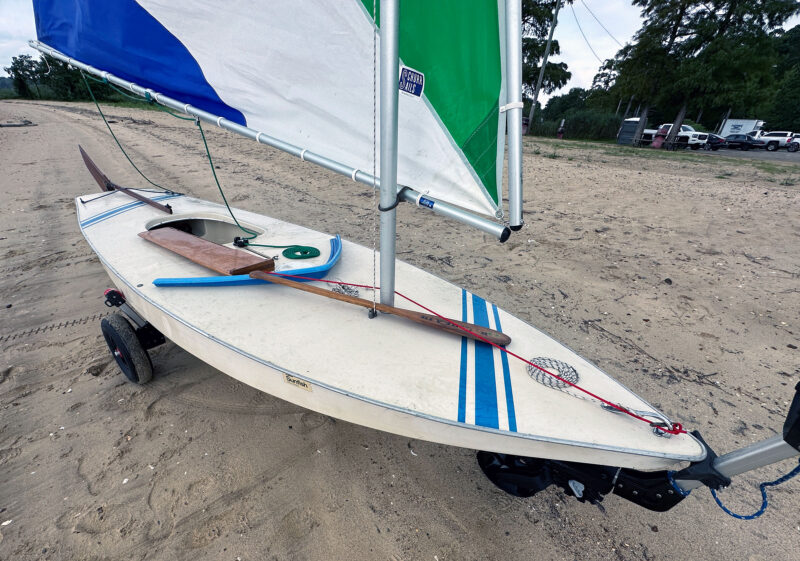 Kent Lewis
Kent LewisWhile owing much to its predecessor, the Sunfish is more boat than board. The beam was increased by 12″ to improve stability and a footwell and splashboards were added. The sail is no longer laced to the spars and now attached with clip rings.
Between 1952 and the mid-1960s, the Sunfish was built in plywood and kits were available. We acquired hull number 13 of the pre-production boats and restored it in 2013. Based on the emerging popularity of fiberglass construction in the late 1950s, ALCORT produced the first fiberglass Sunfish in 1960. It was immensely popular for recreational sailors as well as one-design racers, so popular that it was inducted into the American Sailboat Hall of Fame in 1995.
The Sunfish is a medium-sized hard-chined pontoon-hull dinghy with a length of 13′ 9″ and a 4′ 1″ beam. Draft with the daggerboard down is 2′ 11″ and the modern-day hull weighs 120 lbs. (The ALCORT hulls of the 1960s were built a little stouter, with hull weights of 139 lbs.) Crew capacity is 500 lbs and there is just enough room for two adults. The optimal weight for a solo sailor is up to 190 lbs.
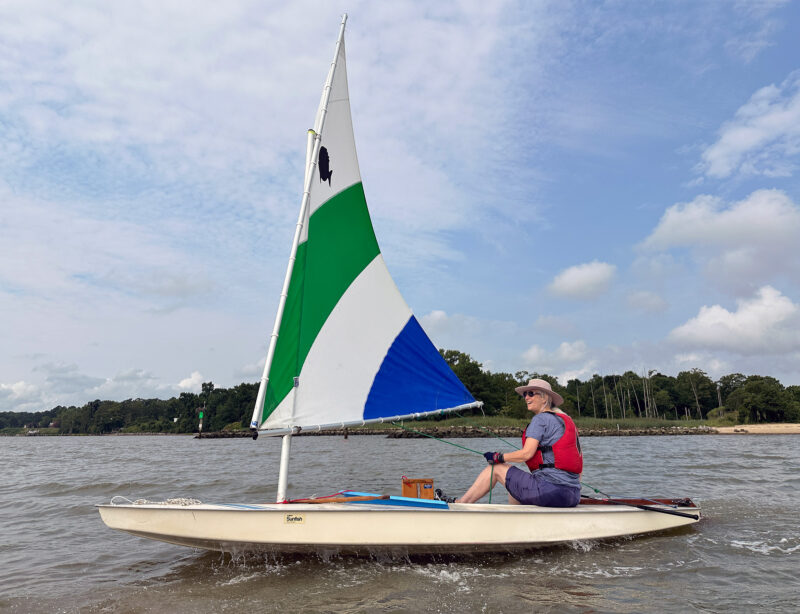 Kent Lewis
Kent LewisDespite the raised freeboard and the splashboard forward of the footwell, the Sunfish is still a wet boat, making it more popular in areas with warmer water.
The virtually unsinkable pontoon hull of most fiberglass Sunfish contains six closed-cell expanded-polystyrene blocks—three in the bow and three in the stern—which structurally tie the hull to the deck. The 2″-wide blocks are held in place by marine-grade foam, which provides additional flotation. If you consider buying an old Sunfish, it is wise to make sure that the internal foam is not waterlogged (by weighing it) or detached (by pounding lightly on the deck and hull with your hand to tell if it feels and sounds solid). Recent Sunfish have internal plastic air bladders for flotation.
New boats can be ordered with either a mahogany or Fiber Reinforced Polymer (FRP) rudder and daggerboard. Whether choosing the classic look of wood or the stronger FRP material, the 44″-long daggerboard and foil-shaped rudder offer excellent control on all points of sail. The daggerboards have increased in length through the years from 31″ on the early wooden hulls to 39″ for the fiberglass boats, and then 44″ for the latest racing daggerboard. The newest daggerboards are foil-shaped. Rudder design has also evolved: from a round blade to a spoon tip to the angular blade shape that has been in use since 1971, when the rudder system was changed from the patented rudder-releasing mechanism made in bronze by Wilcox & Crittenden to an aluminum gudgeon, pintle, and spring design. The new system allows the sailor to raise or lower the rudder while seated in the cockpit, and the rudder will also easily kick up by itself for beaching or if an underwater obstacle is struck.
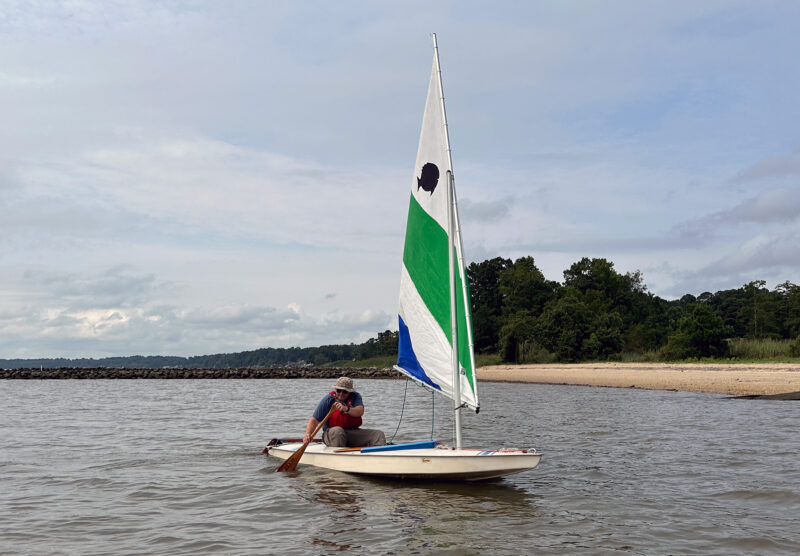 Audrey Lewis
Audrey LewisWhen becalmed, the Sunfish is easily paddled. If alone and using a single-blade paddle, a sailor can hold the helm over with their body and thus maintain directional stability while keeping both hands free. When the paddle is not needed, it can be stowed on the foredeck, held in place with its grip on the splashboard, the shaft between the halyard and the mast, and the blade beneath a line stretched taut across the deck from the bow.
The 75-sq-ft lateen rig sail with its single sheet, and a basic tiller and extension—one string and one stick—are all that is needed for a day of sailing. The spars are made of anodized T 6061 aluminum, with the 13′ 9″ booms being held aloft by a 10’ aluminum deck-stepped mast. The sail was originally lashed to the booms with cord but now has plastic sail clips that look like shower curtain rings. The original sails were cut from cotton by Old Town, but when Dacron debuted, Ratsey & Lapthorn became the sailmaker of choice introducing a little extra draft into the foot of the original flat five-panel sail. Since 1979 Sunfish sails have been made by North Sails. Sail controls for the recreational rig include outhauls for the upper and lower booms. For the racing rig, there are extra lines run to the lower boom that control a cunningham to adjust the luff tension and another line to control the foot tension. With this rig, all skill levels, from beginner to expert, can go out and have a great time on the boat.
Sunfish have been built by several manufacturers with most of the boats from the 1970s through the early 1980s produced by ALCORT, a division of AMF, one of the largest American recreational equipment companies. During the peak of AMF/ALCORT’s production as many as 60 Sunfish a day were leaving the factory in Waterbury, Connecticut. The manufacturer of the boats since 2007 has been Laser Performance, with hulls now built in Portugal after stints in the UK and a short period in China.
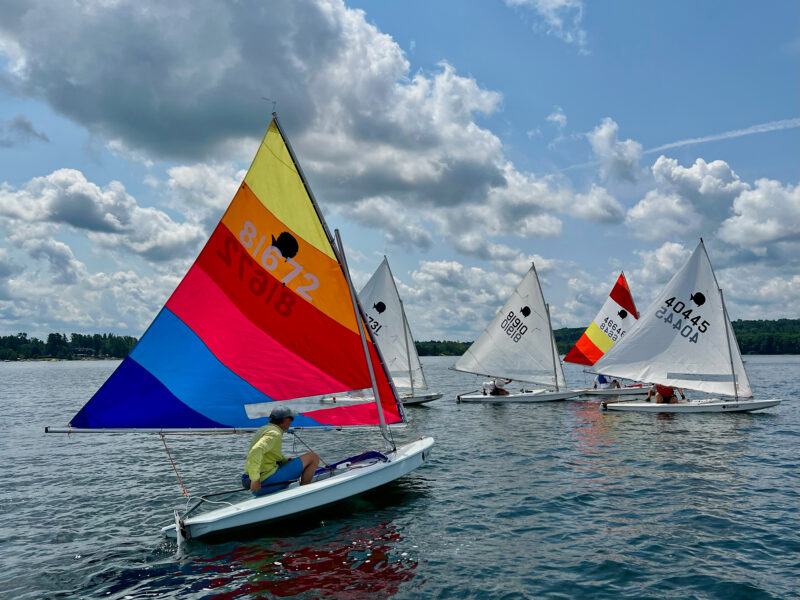 Elizabeth Belden Handler
Elizabeth Belden HandlerMore than 500,000 Sunfish have been built and regattas are popular around the world. The regatta pictured here was hosted in July 2024 by Willow Bank Yacht Club on Cazenovia Lake in New York. A one-day regatta of five races, it welcomed all classes of “legal” Sunfish.
Along with the rudder system change in 1971, a storage cubby was added under the aft end of the cockpit, and around the same time, the DePersia Venturi bailer went from aluminum to plastic construction, a welcome change from the earlier version, which was susceptible to corrosion. The bailer allows the cockpit to self-drain when the boat is making even just a few knots of headway, and closes off with an internal float ball or plug inserted from inside the cockpit. The foredeck has a bow handle; newer hulls with their rolled gunwales are easier to handle on the beach. The original tillers were wooden, usually cut from ash, while modern tillers are aluminum, either straight or wishbone style. The original Sunfish had no sheet fairleads; then a small open fairlead was added to the cockpit lip—the “sheet hook”—and in the 1980s a swivel cam cleat was introduced. Today’s boats usually sport a ratchet block on a stand-up spring set just ahead of the cockpit. Another upgrade was the addition of a hiking strap mounted close to the cockpit floor.
Our current fleet includes the 1953 wooden hull, a 1965 ALCORT, and two AMF boats from 1981 and 1982. They all sail wonderfully, and we appreciate even the older hulls, which weigh a few more pounds but are resistant to oil-canning and can take a beating about as well as the thicker fiberglass construction of the ALCORT Sunfish. The sail hoists easily with one halyard that passes through a deck block or bullseye fairlead to a horn cleat, while the sheet runs from a bridle spanning the aft deck, through two boom blocks and back down to the cockpit.
Launching requires pointing the bow into the wind, pushing the rudder down, and shoving off. After getting settled on the cockpit edge, the daggerboard goes down a bit, and the sailor falls off and sheets in. Skipper Audrey likes to put her boat on the chine and hike out, while other folks prefer to sail flat. The boat tacks smoothly and, with the tiller over just shy of the deck edge, carries enough speed to avoid getting caught in irons. On a run, the daggerboard can be raised, and it will usually stay in place on its own, but the latest trick is to run a bungee from the bow handle back to the daggerboard to cant the board in the trunk and hold it in the selected spot. The bungee or a line should always be used to tether the daggerboard to the hull to keep it from going astray in a capsize—you stand on the daggerboard to right the hull.
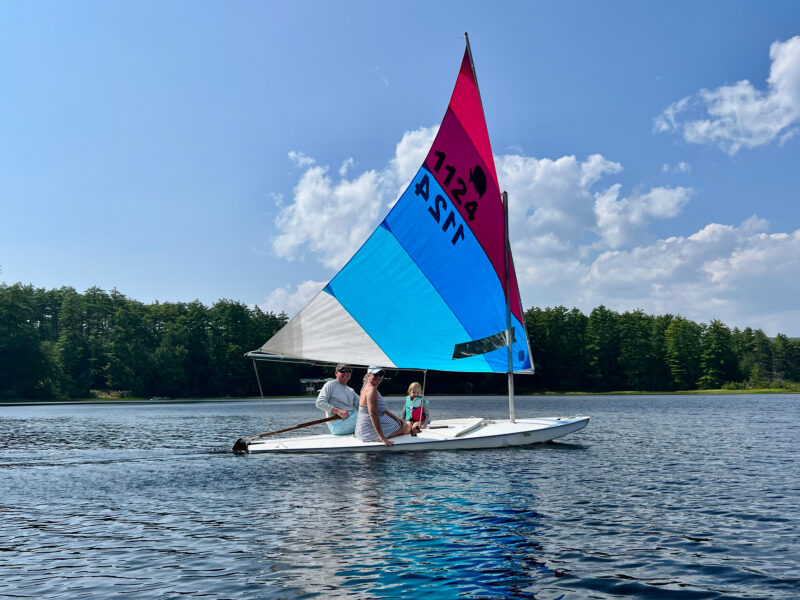 Richard Staples
Richard StaplesOn a calm warm day, the Sunfish is a fun boat for a family outing. In winds over 15 knots however, the boat can be a handful and more suited to a crew of one or two experienced sailors.
Sunfish behave admirably up to around 15 knots of wind; above that people and parts start breaking, and only a few of our most experienced racer friends tempt the more challenging conditions. If the wind dies, put the rudder down and the Sunfish will paddle well with a single-blade paddle or kayak paddle. We’ve even used a Sunfish as a stand-up-paddle platform—very stable but also heavy. The boat is quick to rig, which maximizes time on the water. While a Sunfish and its spars are cartoppable, lately we have been using our utility trailer and dolly.
New Sunfish are produced by Laser Performance and shipped worldwide. Used examples are available in many areas. Look for a relatively clean boat with minimal hull damage and dry, intact foam innards. The spars should be straight. New and used sails, rudders, and daggerboards can be tracked down through dealers or on various social-media platforms. All the parts are interchangeable on the fiberglass fleet with the exception of the old versus new rudder systems. Resale value is high, so you can’t go wrong with a moderately priced, ready-to-sail Sunfish.
With our Sunfish we have found a hobby, fun, and friendship while breathing new life into numerous classics. What comes free with every Sunfish, whether new or used, is a welcoming global community of Sunfish Sailors.![]()
Kent and Audrey Lewis have been messing about with Sunfish for decades and are experts at basket-case restorations. Knowledge gleaned from dozens of restorations is compiled in The Sunfish Owner’s Manual and logged at Small Boat Restoration.
Sunfish Particulars
Length: 13′ 9″
Beam: 4′ 1″
Draft: 2′ 11″
Sail area: 75 sq ft
Hull weight: 120 lbs
The Sunfish Recreational, manufactured by Laser Performance, sells for $5,950 and the Sunfish Race with race sail and additional control lines sells for $6,150.
The Sunfish Forum is a good source for further information.
Is there a boat you’d like to know more about? Have you built one that you think other Small Boats readers would enjoy? Please email us your suggestions.
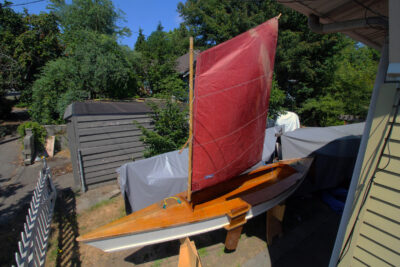
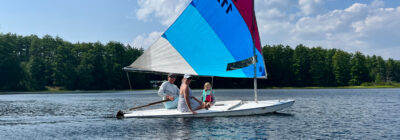
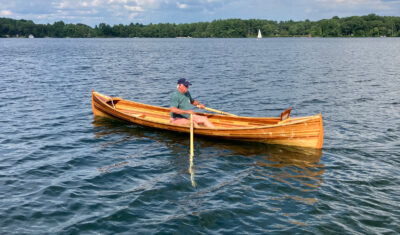
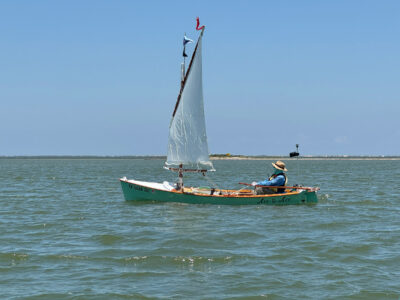
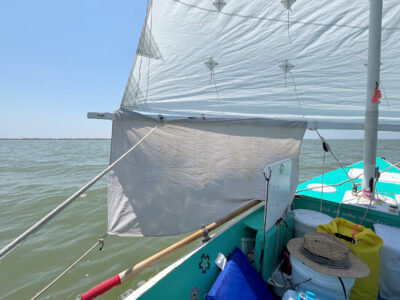
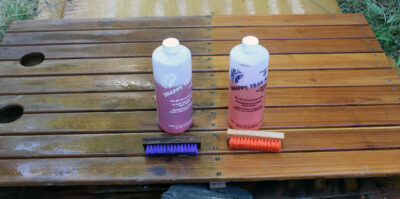
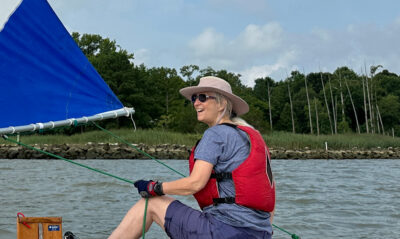
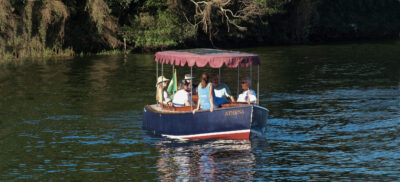
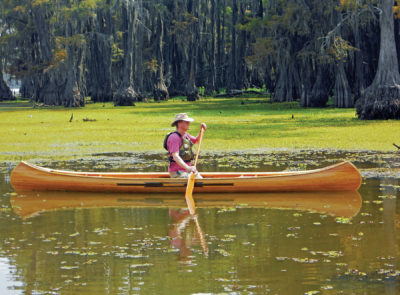
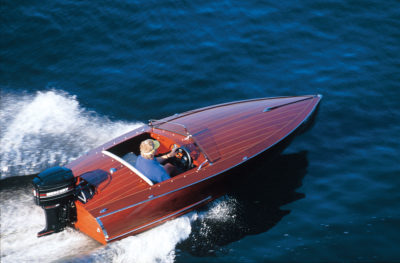
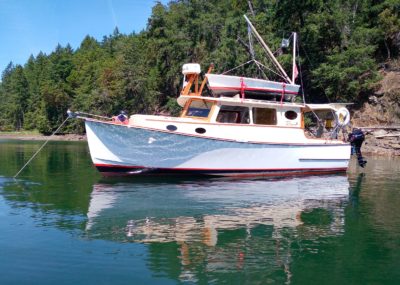
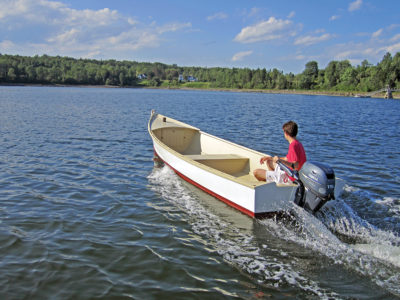
I’m intrigued by the lateen rig on the Sunfish. I presume this is largely self-vanging, like a balanced lug. The rig has the advantage that it can be dropped in a squall, something that can’t be done with the sleeved Laser sail.
No vang per design, but folks add one for racing performance by using the excess halyard back through the deck fairlead and up around the gooseneck swivel, then tied off. Or a variation on that theme.
We like to keep the boat simple, one stick, one string.
Researching all this for an exhibit at Mystic a decade or two ago, I found some interesting tidbits. Al and Cort were iceboat builders and canoe sailors; they responded to a request by the Red Cross for a paddle board for lifeguards, and came up with a prone paddle boat not unlike today’s stand-up paddle boards. They were turned down, so figured out something else they could do with their work. So stick in a daggerboard and add the lateen sail that was standard in open-canoe sailing.
A friend of a friend had a connection to Life and got the right photog and writer to do a spread. I think it ran over several pages, maybe in the center. It’s hard to imagine a similar media impact that would have today: viral when it hit the stands. It was the only capsize, right, and sail away boat in existence then.
A contributing factor, possibly one of the major factors in the Sunfish was that Mrs. Bryan was pregnant and found the Sailfish difficult to sail. A cockpit made all the difference.
Aileen Shields came from good sailing stock, her father was Cornelius Shields. The family knew a thing or two or three about sailing.
I once had my in-laws’ Sunfish planing on a beam reach on Canandaigua Lake and held my own against a 25′ Wianno Senior.
Nicely written, Kent. Only comment is a pontoon is usually paired or threes, like a catamaran or trimaran. The Sunfish hull is a monohull. The monohull Butterfly and further scows are tunnel hulls. Keep on saving Sunfish!
I think Kent is talking about the hull shape. When viewed in cross section, the bottom edges dip down.
I’m amazed how bruised up a sailor can get with a Sunfish on a breezy day! Kent’s observation about the change in behavior in 15 knots or above is true to my experience!